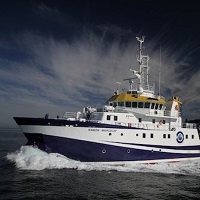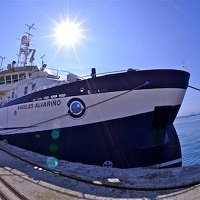Keyword
Carbon monoxide and dioxide concentrations in the atmosphere
21 record(s)
Type of resources
Categories
Topics
INSPIRE themes
Keywords
Contact for the resource
Provided by
Years
Formats
Status
-

Water masses distribution and effect of the upwelling system in the local ecosystem of the Canary Archipielago
-
NA
-

Main objetive of the project VULCANA, is assess the degree of affection and recovery of the marine ecosystem of the submarine volcano of the island of El Hiello, extending it to any other region of the canary islands sensitive to underwater volcanic activity. For this purpose, the physical-chemical, biological and geological properties of the eruptive process will be monitored in the island of El Hierro and other sensitive places, giving continuity to the temporary series of multidisciplinary data of a monogenetic submarine volcano in Spanish waters.
-

The main target of the "VULcanología CAnaria submariNA, VULCANA" project, is to study from a physicochemical, biological and geological point of view underwater volcanoes and hydrothermal systems active or not in the entire Canary basin. In addition, special attention will be given to the continuity of studies carried out in the Tagoro submarine volcano on the island of El Hierro, continuing like this, with one of the Longest physical-chemical-biological time series in the Spanish territory. The specific objectives of the Vulcana1119 campaign will be: 1. Continue with the physical-chemical monitoring studies of the only active underwater volcano in phase of degassing of the Spanish territory, Tagoro submarine volcano, on the island of El Hierro. 2. Determination of the speed of protein synthesis (estimate of production of new biomass) in planktonic microbial communities using the technique proposed by Smith and Azam in 1992.
-

The main objective of the project "VULcanología CAnaria submariNA, VULCANA", is assess the degree of damage and recovery on the marine ecosystem of the volcano submarine of the island of El Hierro, making it extensible to any other region sensitive to underwater volcanic activity in the archipelago. To do this, he held the monitoring of the physico-chemical, biological and geological properties of the submarine process of the island of El Hierro and other areas of volcanic interest, giving continuity to the first and only time series data of a multidisciplinary monogenetic submarine volcano in Spanish waters. 1 .- Study of the spatio-temporal variability of physical, chemical and biogeochemical. 2. Evaluation of the impact of the eruption process of trophic lower levels. 3. physiographic, morphological and structural characterization of the seabed associated emissions and adjacent offshore areas.
-

The main objective of Vulcano-II project "Physico-chemical, biological and geological study of an underwater volcano in a degassing stage: island of El Hierro", is assess the degree of damage and recovery on the marine ecosystem of the volcano submarine of the island of El Hierro. To do this, it held the monitoring of the physico-chemical, biological and geological properties of the submarine process of the island of El Hierro giving continuity to the first and only time series data of a multidisciplinary monogenetic submarine volcano in Spanish waters.
-

The goals of this campaign are framed within the objectives of the overall project 'Radial Profunda de Canarias', being the experimental cruise of the proposal. Thus, this cruise will help to: ¿ Determine the structure of the current when it reaches the Canary Islands, mass transport, heat and nutrients and interannual variability. ¿ Characterize the different modes of variability of heat and mass transport in easternorth atlantic subtropical gyre. ¿ To determine the correlation between heat and mass transport with the NAO atmospheric and oceanic index. ¿ Characterize the annual cycle in the physical conditions of the surface layers and mixture to where the seasonal cycle is significant, relating it to the meteorological forcings. ¿ Characterization of changes in water masses, mainly in the North Atlantic Central Water (NACW), in Antarctic Atlantic Intermediate Water (AAIW) in Mediterranean Water (MW) and bottom waters of the Canary Basin, in based on temperature, salinity, nutrients and oxygen. ¿ Characterize the zooplankton in the waters of the Canary archipelago, including biomass, abundances and taxonomy, as well as your metabolism: respiration, growth, excretion, ingestion, etc.
-

The main objective of the project "VULcanología CAnaria submariNA, VULCANA", is assess the degree of damage and recovery on the marine ecosystem of the volcano submarine of the island of El Hierro, making it extensible to any other region sensitive to underwater volcanic activity in the archipelago. To do this, he held the monitoring of the physico-chemical, biological and geological properties of the submarine process of the island of El Hierro and other areas of volcanic interest, giving continuity to the first and only time series data of a multidisciplinary monogenetic submarine volcano in Spanish waters. 1 .- Study of the spatio-temporal variability of physical, chemical and biogeochemical. 2. Evaluation of the impact of the eruption process of trophic lower levels. 3. physiographic, morphological and structural characterization of the seabed associated emissions and adjacent offshore areas.
-

The main objective of the project "VULcanología CAnaria submariNA, VULCANA", is assess the degree of damage and recovery on the marine ecosystem of the volcano submarine of the island of El Hierro, making it extensible to the volcano "enmedio", between the islands of Gran Canaria and Tenerife. To do this, he held the monitoring of the physico-chemical, biological and geological properties of the submarine process of the island of El Hierro and the submarine volcano "enmedio", giving continuity to the first and only time series data of a multidisciplinary monogenetic submarine volcano in Spanish waters. 1 .- Study of the spatio-temporal variability of physical, chemical and biogeochemical. 2. Evaluation of the impact of the eruption process of trophic lower levels. 3. physiographic, morphological and structural characterization of the seabed associated emissions and adjacent offshore areas.
-

The main objective of the project VULcanology CAnaria submariNA, VULCANA, is to study from a physical-chemical, biological and geological point of view submarine volcanoes and hydrothermal systems active or not in the entire Canary basin. In addition, special attention will be paid to the continuity of the studies carried out in the Tagoro submarine volcano on the island of El Hierro, continuing, with one of the longest physical-chemical-biological time series in Spanish territory. The specific objectives of the Vulcana1118-ROV campaign will be: 1. Visualization and sampling around the anchoring carried out during the previous campaign (Vulcana-II-0318). The physical-chemical anchor will recover by autonomous pathways with acoustic release. If these techniques fail, the ROV will be used to completely recover the reinforced concrete block with all its sensors from inside the main crater of the Tagoro submarine volcano, at a depth of 127m. 2. Realization of a uniform regular mesh over the entire Tagoro volcanic building with the ROV for the realization of a complete map of the hydrothermal vents. Physical-chemicalbiological and geological samples of the interior of each of these points will be collected with the use of ROV arms and specifically designed samplers (pressure bottles with on / off valves, inverted funnels, mini-ctds, micro- thermal sensors, etc). 3. Placement and collection of physical instruments in test phase on active hydrothermal environments (areas with physical sensors in self-contained and with automatic release capacity - Kaust). The writing of some task related to this objective would be missing in the established format (objective, methodology, responsible researcher, institution, etc.). 4. Continue monitoring studies of the only active submarine volcano in the degassing phase of Spanish territory, Tagoro underwater volcano, on the island of El Hierro.
 Catálogo de datos del IEO
Catálogo de datos del IEO